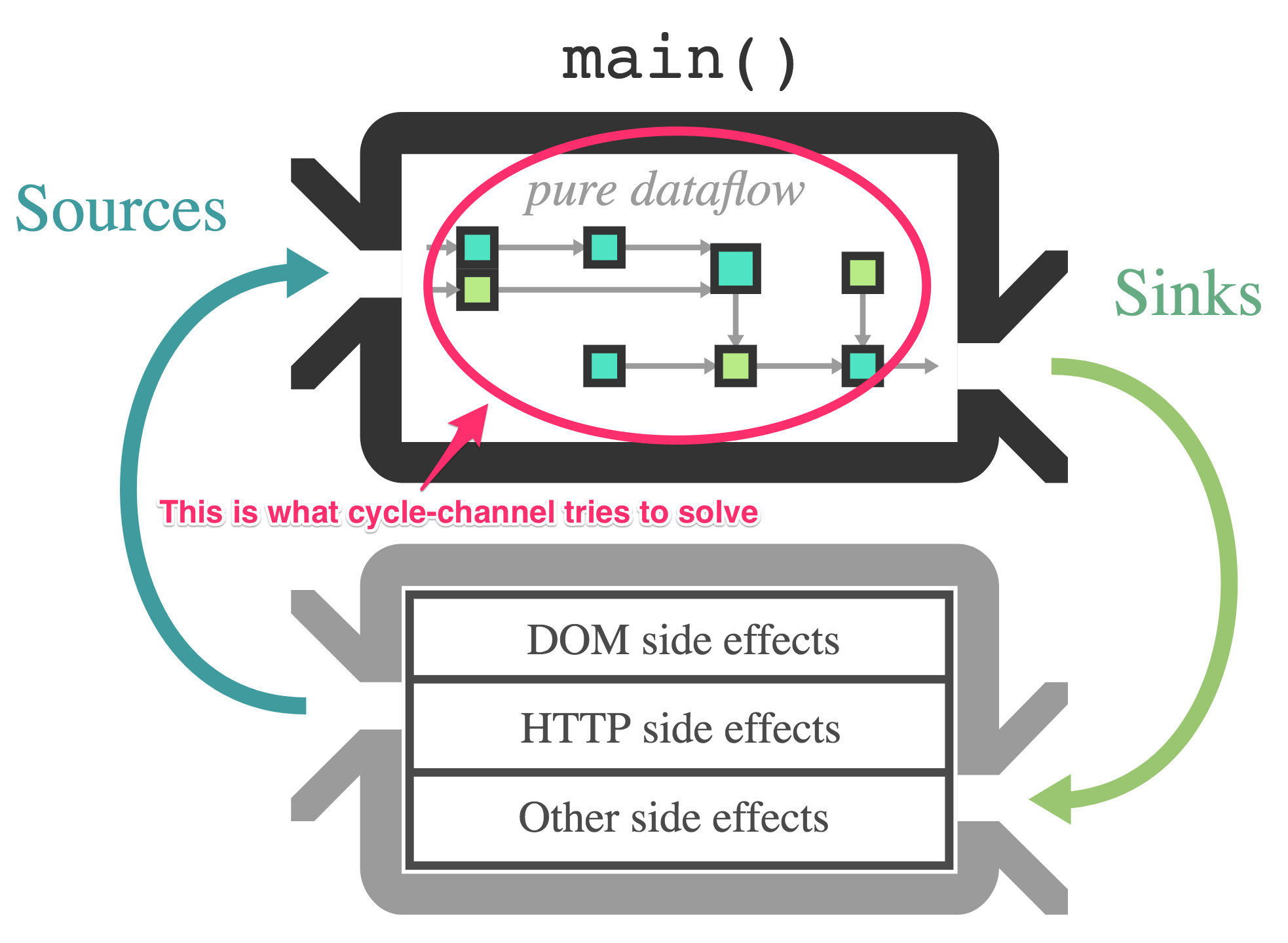2.0.0 • Published 8 years ago
cycle-channel v2.0.0
cycle-channel


Cycle.js is a fantastic framework for handling the cyclical stream-based nature of UI, but it doesn't give that full-framework feeling by itself. In comes cycle-channel, explained by the below image:

This means that cycle-channel is a single pipeline of driver sources to driver sinks. The core point of cycle-channel (and the sublibraries) is to provide a unified interface for data and actions and their intertwined behavior. This kind of logic often gets written by hand and instead I prefer to have something stable.
Usage
For this example I've removed the import statements for anything that isn't really important.
import {channel} from "cycle-channel"
import {stateDriver} from "cycle-channel"
import {dataDriver} from "cycle-channel"
import {viewEventSignals} from "cycle-channel-dom"
import {networkResponseSignals} from "cycle-channel-http"
import {storageReadSignals} from "cycle-channel-storage"
import intent from "snabbdom-intent"
// NOTE: See https://github.com/krainboltgreene/snabbdom-intents for more information
const intents = {
onChangeSearch: intent({change: ["updateFormField", "fetchSearchResult"]})
}
// NOTE: This function will render our view layer.
const render = ({state}) => {
// NOTE: See https://github.com/krainboltgreene/snabbdom-intents for more information
const withSearch = intents.onChangeSearch({
form: "search",
field: "query",
})
return main({
children: [
h1({children: "Google"}),
input(withSearch({children: state.ephemeral.forms.search.query})),
p({children: "See below for the results"}),
ul({children: mapValues((result) => li({children: result.title}))(state.resources.results)}),
],
})
}
const application = ({view, network, storage}) => {
return channel({
// NOTE: Signals are streams of signal emits, mapped from sources. The below functions each know how to turn a native event from that source into a standardized signal that can be reacted to or transformed into a message.
signals: [
// NOTE: For example, this is a stream of signals from view layer events
viewEventSignals(view),
// NOTE: This is a stream of signals from http responses
networkResponseSignals(network),
// NOTE: This is a stream of signals from the local storage driver
storageReadSignals(storage),
],
// NOTE: This is the start of your application's state. You might want something more complicated than this.
initialState: {},
// NOTE: Reactions are the functions that fire in response to certain signals. They receive the current state and the payload). They return the next state:
reactions: {
// reaction:: State => {event?: Event, [name?: Key]: mixed} => State
updateFormField: (state) => ({event, form, field}) => {
return mergeDeepRight(
state
)(
recordFrom(["ephemeral", "forms", form, field])(event.target.value)
)
},
mergeResources: (state) => ({data}) => {
return mergeDeepRight(
state
)({
resources: treeify([groupBy(keyChain(["attributes", "type"])), indexBy(key("id"))])(data)
})
},
},
// NOTE: Transforms are functions that take state and a payload and turn them into transmissions meant for drivers. For example, you may want a button press to trigger a http request. They must return a Transmission:
transformers: {
// transform:: State => {event?: Event, [name: Key]?: mixed} => {driver: string, data: mixed}
fetchSearchResult: (state) => ({event}) => {
return {
driver: "network",
data: {
method: "GET",
url: `https://api.example.com/search?query=${event.target.value}`,
headers: {Authorization: `Basic ${state.ephemeral.authorization}`},
},
}
},
},
// NOTE: Drains are sinks that always happen, regardless of the type of message. Views are a good example, because state might have changed
drains: {view: stateDriver(render)},
// NOTE: Vents are sinks that only happen when a Message has the `driver` property of the same name as the key, so a the above search request would go down the network sink.
vents: {
network: dataDriver(),
storage: dataDriver(),
},
})
}
const drivers = {
view: makeDOMDriver("body"),
network: makeHTTPDriver(),
storage: storageDriver(),
}
run(application, drivers)